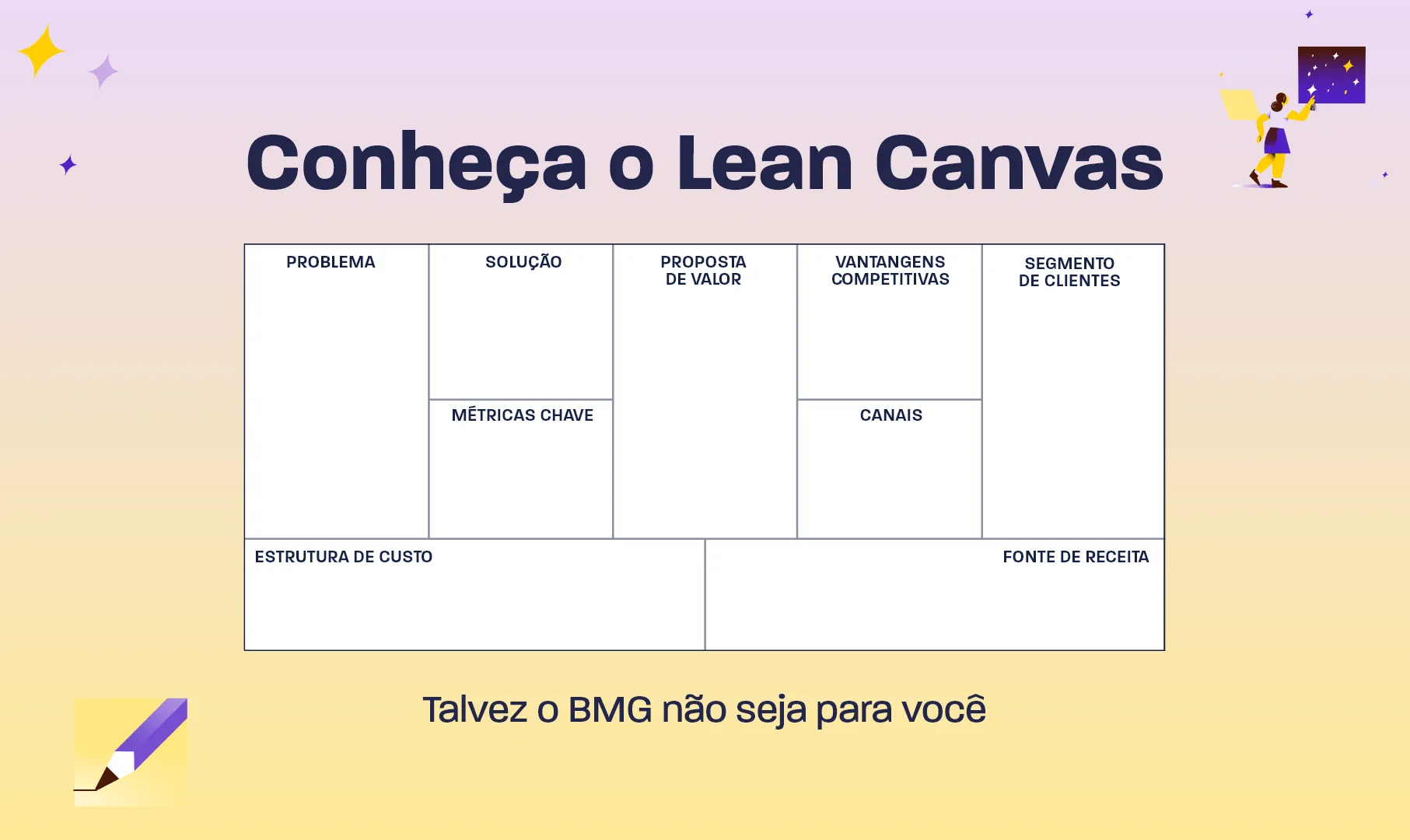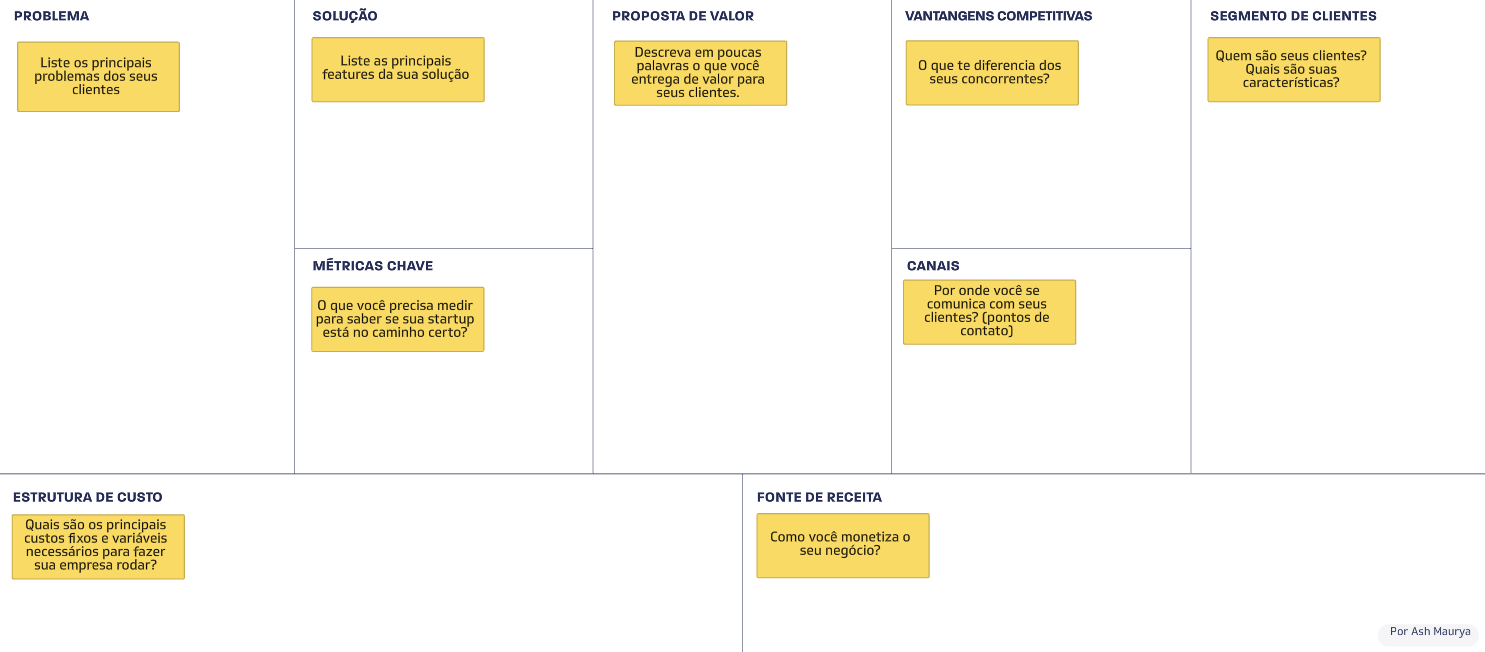Lean Canvas: the canvas for startups

Strytegy
January 13, 2022
Learn how to create a Lean Canvas, the business model canvas especially designed for developing startups.

What is the Lean Canvas?
Lean Canvas is a template for creating business models concisely, adapted for the reality of startup companies. It was created by Ash Maurya, author of best-seller book Running Lean, and was inspired by the famous Business Model Canvas (BMG) by Alex Osterwalder. This canvas replaces 4 of the original 9 fields in BMG, in order to focus on aspects that are most relevant to startups.
Startups are businesses that are born with the goal of disrupting the market, offering an innovative product that will allow them to reach rapid and exponential growth. Because of this innovation aspect, these companies deal with a lot of uncertainty, and need to validate fundamental hypotheses to make sure they are investing in the right idea. Lean Canvas contemplates these main challenges of young businesses.
Why is this canvas ideal for startups?
The Lean Canvas template replaces 4 from the initial 9 fields in BGM: instead of Key Partners, Key Activities, Key Resources and Customer Relationships, we have Problem, Solution, Key Metrics and Unfair Advantage.
Eric Ries, in his book Lean Startup, shows us that a startup needs to validate hypotheses. Is this problem I am trying to solve real, and has the potential to lead me to exponential growth? Is the solution I am building what solves this problem? These hypothesis tests happen fast and systematically, so it is important to keep track of the correct metrics to determine whether the assumption is correct or not. Based on these ideas, the Lean Canvas urges you to list the main Problems, Solutions, and Metrics that guide the creation of your startup.
The field of Unfair Advantage relates to the very essence of startup companies: disrupting the market. If you don’t know what makes you stand out among your competitors, you won’t be able to reach the scale every startup founder wants.
How to create your own Lean Canvas?
The first thing you need is to assemble the template. You can draw it or print it on paper, or you can use a free digital template in Strytegy.
We are going to split this section in 2 parts: the first one covers the part that is exactly the same as BMG; and the second covers the altered fields.

Part 1: BMG
1. Value Proposition: here you should describe in a concise and clear manner, how your company solves the consumer’s problems, and why it does so better than all other competitors.
2. Channels: describe here the ways you communicate with your customers. It can be your website, social media, physical stores, etc.
3. Client Segments: describe you target market. Who are the consumers you are trying to sell to?
4. Cost Structure: organize here your main costs, both variable and fixed, to create a picture of how much it costs to get all your operation running.
5. Revenue Streams: how does your startup make money? Describe where your revenue comes from.
If you need more detail about how to fill out this part of the canvas, you can access here an article we made with an easy step-by-step guide to create you BMG.
Part 2: Lean Canvas exclusive fields.
6. Problem: write here the main problems your company is trying to solve. Remember that, in this moment, you should focus on your target market, since the problem arise from the needs of your customers. Try to keep the number of problems low (no more than 3), since it is important to maintain focus. Startups have scarce resources, so it is better to concentrate on a few key points rather than trying to solve everything at once.
7. Solution: the solution field is different from the value proposition. Here you should describe the main features of your product that will solve your customer problems. Remember that a startup is always trying to validate hypotheses, so you should be able to verify if the solutions you are listing are solving the problems you just wrote. Again, it is important to keep the number of features low (no more than 3).
8. Key Metrics: Eric Ries also tells us about accounting for innovation. Every time a startup iterates on a product, it should measure what is learned, and have clear indicators to determine the success or failure of the initiative. Therefore, list here the main metrics that can determine the success of your startup and show you that you are on the right path.
9. Unfair Advantage: This field refers to your company 's differential, what makes it unique in the market. This competitive advantage can’t be bought or easily imitated by your competitors. It can be a great team, an innovative technology, specialists backing you up, etc.
Conclusion
If you are starting a new business and have a dream of growing exponentially and changing the rules of the market, Lean Canvas can be the ideal tool to guide your efforts. Similar to BMG, the concise format of this template allows for rapid changes in your business model, keeping-up with the accelerated rhythm of startups. It will help you guide your company in the right path, without losing flexibility and speed.
Try out our free Lean Canvas Template in Strytegy! Just create your account and start putting your ideas into action.
